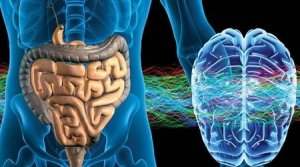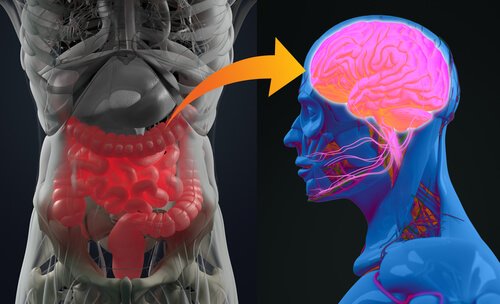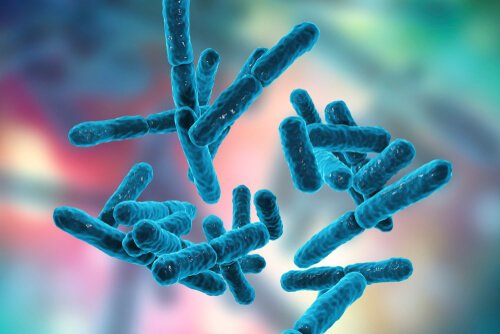The Enteric Nervous System: The Second Brain


Written and verified by the psychologist Valeria Sabater
The enteric nervous system is often considered our ‘second brain’. It’s a complex network of more than a hundred million neurons that cover specific areas such as the small intestine and colon. Additionally, this system is capable of acting independently of the brain itself.
Without a doubt, we could say that this part of the autonomic nervous system, which is responsible for regulating the digestive processes, is one of the most interesting parts of our body. In recent years, there have been publications that state that the enteric nervous system is our second brain.
However, we should mention that a part of the scientific community doesn’t agree with this assumption. Dr. Michael D. Gershon’s work on this topic is very famous. He’s the president of the Department of Pathology and Cell Biology at Columbia University. In his book, The Second Brain, he elaborates on important discoveries. For example, 95% of serotonin and 50% of dopamine come from the gastrointestinal system.
In May of this year, Flinders University in Australia discovered something even more striking, which they published in The Journal of Neuroscience. Namely, they discovered that the enteric nervous system is capable of generating electrical activity. It does so with a very unique and different pattern than the brain’s.
Learning more about this structure can reveal aspects of ourselves that we didn’t know.
“The knowledge we have of the functions of the enteric nervous system has remained at the level of the Middle Ages. It’s time to discover everything it does for us.”
-Dr. Michael D. Gershon-

The enteric nervous system: Location and functions
The enteric nervous system is very large. In fact, it starts at the esophagus and ends in the anus. It covers the entire digestive system and has an average length of 30 feet. As we’ve already mentioned, there are many neurons inside this organ, just like in the intestines.
Another interesting aspect is that, in addition to being highly specialized, this part of the body carries out its functions autonomously. Moreover, although it communicates with the help of the central nervous system, it’s capable of sending a lot of information to the brain itself. Now, let’s have a look at some more facts and characteristics.
The enteric nervous system is more than just digestive processes
- In the enteric nervous system, you can find millions of neurons, neurotransmitters, virus, and bacteria. All of these elements regulate our well-being and our health.
- There are three types of neurons in this region: efferent neurons, afferent neurons, and interneurons.
- The neurotransmitters that regulate the processes of these nerve fibers are acetylcholine, noradrenaline, and adrenaline.
- Additionally, like the nervous system itself, the enteric nervous system synthesizes serotonin, dopamine, opioids for pain, etc. This is why we can call it our body’s chemical lab.
- Professor Gary Mawe of the Department of Neurological Sciences at the University of Vermont points out that nothing is as complex and delicate as digestion. Thus, we must remember that the enteric nervous system determines which digestive enzymes are the best to break down each type of food.
- It even monitors acidity, promotes bowel movement, and monitors our defense levels.
- There’s evidence that it’s able to detect if there are any bacteria in the food we’ve eaten. If so, it will induce processes such as vomiting or diarrhea.

The brain, the vagus nerve, and the enteric nervous system
We already stated that the enteric nervous system is capable of working independently of the central nervous system. This is especially fascinating because, as Dr. Michael D. Gershon points out, the intestine is the only organ in the body that can function autonomously.
However, it needs to communicate with the brain at certain times. In this regard, it communicates through the vagus nerve.
Emotional communication between the brain and the enteric nervous system
The Duke Biomedical Engineering School did a study which found that nine out of ten communications between the brain and the intestine start in the brain.
- One of the messages between the enteric nervous system and the brain is to signal the latter when we’re hungry and when we’re full. It does so by regulating a series of hormones that produce a sensation of well-being and satisfaction.
- Likewise, these set of nerves also give the brain a sensation of pleasure when we consume food that we like or that is pleasurable to us.
- When we experience stress, the enteric nervous system is very sensitive to this state and generated changes. For example, the so-called ‘stomach knots’ make the system increase the blood flow to this area.
- In the last few years, a series of investigations are being carried out to discover how intestinal microbes affect our behavior and emotions. We know that bad bacterial flora can affect our mood. However, the data still doesn’t support a single hypothesis.

To conclude, we should note one aspect. There are some scientists that consider it a mistake t0 regard the enteric nervous system a ‘second brain’. Although the neurobiological arguments are debatable at the moment, for others, they’re solid enough.
Be that as it may, it’s worth mentioning one detail. These set of nerve fibers don’t ‘think’, but they do feel. The enteric nervous system is sensitive to stress and emotions and is able to regulate multiple bodily functions. Therefore, the enteric nervous system is another essential command center.
The enteric nervous system is often considered our ‘second brain’. It’s a complex network of more than a hundred million neurons that cover specific areas such as the small intestine and colon. Additionally, this system is capable of acting independently of the brain itself.
Without a doubt, we could say that this part of the autonomic nervous system, which is responsible for regulating the digestive processes, is one of the most interesting parts of our body. In recent years, there have been publications that state that the enteric nervous system is our second brain.
However, we should mention that a part of the scientific community doesn’t agree with this assumption. Dr. Michael D. Gershon’s work on this topic is very famous. He’s the president of the Department of Pathology and Cell Biology at Columbia University. In his book, The Second Brain, he elaborates on important discoveries. For example, 95% of serotonin and 50% of dopamine come from the gastrointestinal system.
In May of this year, Flinders University in Australia discovered something even more striking, which they published in The Journal of Neuroscience. Namely, they discovered that the enteric nervous system is capable of generating electrical activity. It does so with a very unique and different pattern than the brain’s.
Learning more about this structure can reveal aspects of ourselves that we didn’t know.
“The knowledge we have of the functions of the enteric nervous system has remained at the level of the Middle Ages. It’s time to discover everything it does for us.”
-Dr. Michael D. Gershon-

The enteric nervous system: Location and functions
The enteric nervous system is very large. In fact, it starts at the esophagus and ends in the anus. It covers the entire digestive system and has an average length of 30 feet. As we’ve already mentioned, there are many neurons inside this organ, just like in the intestines.
Another interesting aspect is that, in addition to being highly specialized, this part of the body carries out its functions autonomously. Moreover, although it communicates with the help of the central nervous system, it’s capable of sending a lot of information to the brain itself. Now, let’s have a look at some more facts and characteristics.
The enteric nervous system is more than just digestive processes
- In the enteric nervous system, you can find millions of neurons, neurotransmitters, virus, and bacteria. All of these elements regulate our well-being and our health.
- There are three types of neurons in this region: efferent neurons, afferent neurons, and interneurons.
- The neurotransmitters that regulate the processes of these nerve fibers are acetylcholine, noradrenaline, and adrenaline.
- Additionally, like the nervous system itself, the enteric nervous system synthesizes serotonin, dopamine, opioids for pain, etc. This is why we can call it our body’s chemical lab.
- Professor Gary Mawe of the Department of Neurological Sciences at the University of Vermont points out that nothing is as complex and delicate as digestion. Thus, we must remember that the enteric nervous system determines which digestive enzymes are the best to break down each type of food.
- It even monitors acidity, promotes bowel movement, and monitors our defense levels.
- There’s evidence that it’s able to detect if there are any bacteria in the food we’ve eaten. If so, it will induce processes such as vomiting or diarrhea.

The brain, the vagus nerve, and the enteric nervous system
We already stated that the enteric nervous system is capable of working independently of the central nervous system. This is especially fascinating because, as Dr. Michael D. Gershon points out, the intestine is the only organ in the body that can function autonomously.
However, it needs to communicate with the brain at certain times. In this regard, it communicates through the vagus nerve.
Emotional communication between the brain and the enteric nervous system
The Duke Biomedical Engineering School did a study which found that nine out of ten communications between the brain and the intestine start in the brain.
- One of the messages between the enteric nervous system and the brain is to signal the latter when we’re hungry and when we’re full. It does so by regulating a series of hormones that produce a sensation of well-being and satisfaction.
- Likewise, these set of nerves also give the brain a sensation of pleasure when we consume food that we like or that is pleasurable to us.
- When we experience stress, the enteric nervous system is very sensitive to this state and generated changes. For example, the so-called ‘stomach knots’ make the system increase the blood flow to this area.
- In the last few years, a series of investigations are being carried out to discover how intestinal microbes affect our behavior and emotions. We know that bad bacterial flora can affect our mood. However, the data still doesn’t support a single hypothesis.

To conclude, we should note one aspect. There are some scientists that consider it a mistake t0 regard the enteric nervous system a ‘second brain’. Although the neurobiological arguments are debatable at the moment, for others, they’re solid enough.
Be that as it may, it’s worth mentioning one detail. These set of nerve fibers don’t ‘think’, but they do feel. The enteric nervous system is sensitive to stress and emotions and is able to regulate multiple bodily functions. Therefore, the enteric nervous system is another essential command center.
This text is provided for informational purposes only and does not replace consultation with a professional. If in doubt, consult your specialist.







